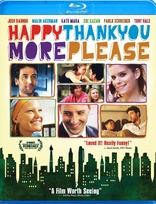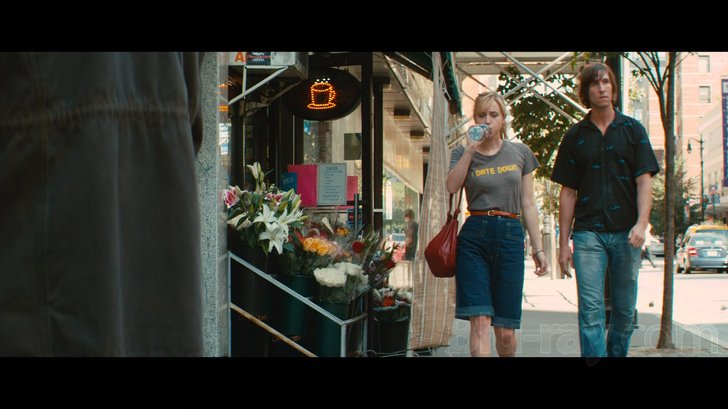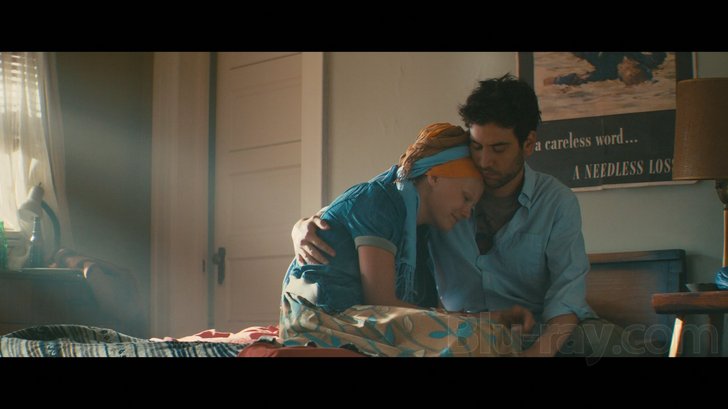Happythankyoumoreplease Blu-ray Movie
HomeHappythankyoumoreplease Blu-ray Movie 
Starz / Anchor Bay | 2010 | 99 min | Rated R | Jun 21, 2011
Movie rating
7.1 | / 10 |
Blu-ray rating
| Users | 0.0 | |
| Reviewer | 4.0 | |
| Overall | 4.0 |
Overview
Happythankyoumoreplease (2010)
Captures a generational moment - young people on the cusp of truly growing up, tiring of their reflexive cynicism, each in their own ways struggling to connect and define what it means to love and be loved.
Starring: Josh Radnor, Malin Akerman, Zoe Kazan, Pablo Schreiber, Kate MaraDirector: Josh Radnor
| Romance | Uncertain |
| Drama | Uncertain |
| Comedy | Uncertain |
Specifications
Video
Video codec: MPEG-4 AVC
Video resolution: 1080p
Aspect ratio: 2.38:1
Original aspect ratio: 2.39:1
Audio
English: Dolby TrueHD 5.1
Subtitles
English SDH, Spanish
Discs
25GB Blu-ray Disc
Single disc (1 BD)
Playback
Region A (C untested)
Review
Rating summary
| Movie | 3.5 | |
| Video | 4.5 | |
| Audio | 4.0 | |
| Extras | 3.5 | |
| Overall | 4.0 |
Happythankyoumoreplease Blu-ray Movie Review
MovieIsBetterThanTitle
Reviewed by Michael Reuben July 9, 2011It took Josh Radnor three years to get his directorial debut, which he also wrote, before the
camera, and yet during the whole time Radnor was a star of the successful TV show How I Met
Your Mother. Imagine, then, how difficult it must be for someone who isn't famous to get an
independent movie made. But at least Radnor's attachment gave the project sufficient credibility
to attract first-rate talent; the cast and crew that made Happythankyoumoreplease (hereafter
"HTYMP") may have been mostly young, but with the exception of eight-year-old Michael
Algieri, who turned out to be a prodigy, it was highly professional. Even its token elder
statesman came from the first rank. The great Richard Jenkins filmed his one scene just after
being nominated for an Oscar for 2008's The Visitor.
The calibre of the craftsmanship is what makes HYTMP worth seeing, because the story is
familiar territory. A loosely connected group of single, educated urbanites in their late twenties
feel adulthood knocking - no, pounding - on the door, and they're both eager to move on and
panicked at the prospect of making irrevocable decisions. Over everything hangs the question:
Will I ever be happy?

Sam Wexler (Radnor) is a writer living in New York City. After eking out a meager existence publishing short stories, he's spent three and a half years writing a novel that no one will publish. As HYTMP opens, he has overslept and is late for a meeting arranged for him by his friend Annie (Watchmen's Malin Akerman) with an editor (Jenkins) at the publisher where she works.
Late as he is, Sam is delayed even more by several developments. First, he stops to admire a woman he passes on the street as she enters the bar where she works. He will later learn that her name, improbably, is Mississippi (Kate Mara, most recently one of the hikers in 127 Hours). An even bigger obstacle presents itself on the uptown subway, where Sam watches what appears to be a family group exit, leaving behind a small boy who doesn't make it to the sliding doors before they slam shut. Against his better judgment, Sam plays Good Samaritan and tries to help the kid, whose name is Rasheen (Algieri), but a transit worker tells Sam to take the kid to a police station and Sam ends up bringing him to the appointment, where things don't go well. Since neither Sam nor Rasheen wants to deal with the police, they end up going together to the party that Annie is throwing that evening, and Rasheen stays in Sam's apartment thereafter.
But first Sam uses Rasheen as an icebreaker with Mississippi. He brings the kid into her bar to get him a glass of water, claiming to be acting as a "big brother" in a program for underprivileged kids. Her heart immediately melts. All this is after Sam has spent the previous night with another woman (whose face we never see), which is what made him late for his appointment in the first place. Clearly, Sam is fighting against growing up with every fiber of his being. In a phrase that one character will later use, he's "a 29-year-old twelve-year-old". (Maybe that's why the editor who read his novel found the hero so vague and indistinct.) Mississippi is cautious, because she's trying to be less casual about sex (or, as she puts it, "to not be such a whore"). What she really wants is for Sam to come hear her sing at the cabaret where she performs after work. As Sam cares about writing, she cares about singing.
Sam's "cousin", Mary Catherine (Zoe Kazan), who isn't really a blood relative, is horrified at his child companion, grasping immediately that Sam can't just keep a kid he finds on the street. But Mary Catherine has her own issues to deal with. Her long-time boyfriend, Charlie (Pablo Schreiber), is in Los Angeles meeting about a potential film project with a friend who's moved there. Mary Catherine feels Hollywood luring Charlie away, and the prospect terrifies her. When Charlie returns suggesting that they relocate, all hell breaks loose.
A third main character is Annie, whose party Sam attends with Rasheen. It's an odd affair. Annie suffers from a rare auto-immune disorder that has caused her to lose all her hair (she calls it "alopecia", which is the generic medical term for hair loss). She has no eyebrows and always wears a colorful scarf wrapped around her bald head. She's staged the party like a "coming out" affair to celebrate her condition, but it clearly weighs heavily upon her. Otherwise, why would she resume her self-destructive affair with Ira (Peter Scanavino), who doesn't hesitate to tell her (after they've slept together) that he's seeing someone else? So lacking is Annie's self-esteem that she can't even acknowledge the obvious interest shown her by the friendly guy from the legal department, who also happens to be named Sam (Tony Hale from Chuck). She calls him "Sam #2", and it's to him that Annie relates the philosophy told her by a cab driver from which the film's title derives.
Because Annie, Sam and Mary Catherine all know each other, Radnor's script successfully avoids the sense of randomness that often afflicts multi-stranded narratives as the film cuts among different plotlines. It helps, too, that the individual stories are unified by an underlying sense of momentous consequences resting on decisions made now. The performances are uniformly excellent and authentic, with special credit to Kazan and Schreiber for their raw portrayal of a couple in crisis.
Still, one cannot escape the sensation that we've seen this movie before, or something like it. Sensitive, artistic upper middle class twenty-somethings suffering from anxiety and Weltschmerz have become a staple of independent film, because that's the description of so many young filmmakers who have been told to "write what you know". Radnor even acknowledges the problem in a speech he delivers as Sam:
My great shame as a writer is that I'm just this suburban kid with good parents. You know, I was fed, clothed, carpooled - hardly Dickensian. Know what I'm saying?To which Rasheen gives the pointed answer: "Totally."
Happythankyoumoreplease Blu-ray Movie, Video Quality 

The film was shot with the Red One digital camera, and director Radnor notes in his commentary
that he enjoys the freedom that digital acquisition gives him, with its thirty-minute uninterrupted
takes, to let the actors continue working while he gives them direction. In pre-production,
though, Radnor told his DP, Seamus Tierney, that he wanted to avoid the harsh, overly sharp
look he'd seen in other digitally acquired movies. Tierney responded by equipping the Red One
with anamorphic lenses, which shortened the depth of field and softened the edges of objects in
the frame. The result is one of the most film-like images I have ever seen in a digital production.
Detail in the 1080p, AVC-encoded image is abundant, even in darker portions of the image,
thanks to solid black levels. Of course, there is no film grain, and there is little or no video noise.
As Radnor notes repeatedly in his commentary, DP Tierney was extremely careful with his
lighting, but where cinematography used to be known as "painting with light", today it must also
be thought of as "painting with pixels", because a major portion of the cinematographer's job
occurs in post-production on the digital intermediate (or "color correction", as Radnor calls it).
A quick comparison of the finished film with the uncorrected deleted scenes gives an idea of the
extent to which post-production manipulation is required to achieve the intended effect. This is
not just a matter of accentuating the blue of the shirt that Sam is wearing in the opening sequence
(to accompany Annie's instruction that he wear "the blue shirt"). It's a matter of creating
shadows, accentuating figures in the frame, redirecting the eye, and altering the entire color
palette. For anyone familiar with the various locations used in the film, Radnor and Tierney have
subtly (and sometimes not so subtly) changed their appearance, often by emphasizing cyan, and
sometimes magenta, throughout the frame, and frequently by deemphasizing green. The result is
to emphasize the artificial and urban nature of the surroundings, because all of these characters
are extremely conscious of the fact that they're city dwellers.
HTYMP is a film for which its makers have clearly taken great pains to get the color just
right. Only on Blu-ray can those colors be accurately conveyed.
Happythankyoumoreplease Blu-ray Movie, Audio Quality 

Because the film is dialogue-driven, the surrounds in the Dolby TrueHD track are largely limited to conveying environmental ambiance. Still, there are a variety of environments to convey: subways, parks, parties, rooftops. The effects are subtle but definite. Dialogue has been clearly rendered and remains anchored to the center where it belongs. The biggest beneficiary of the lossless treatment is the wonderful soundtrack by JayMay (see the Features section for further discussion), with additional selections handpicked by Radnor from Cloud Cult, The Generationals, Shout Out Loud and, for Kate Mara to perform in Mississippi's cabaret act, Kander & Ebb.
Happythankyoumoreplease Blu-ray Movie, Special Features and Extras 

- Commentary with Producer/Writer/DirectorActor Josh Radnor and Producer Jesse Hara: Radnor jokes at the outset that the title of the commentary should be "stating the obvious". While it's true that he and long-time friend Hara tie many of their comments to the action on screen, they work in substantial information about script development (through multiple live readings, as noted in the end credits), casting, locations, the shooting experience and the contributions of such key personnel as the production designer and cinematographer.
- Happythankyoumoremusicplease - Featuring JayMay (SD; 1.78:1, enhanced; 6:41): This short featurette introduces singer/songwriter JayMay, whose spare compositions provide the bulk of the film's soundtrack. Radnor and his music supervisor, Andrew Gowan, explain why they wanted JayMay's music for the film, and JayMay describes how she went about writing new songs to fit their needs.
- Deleted Scenes (SD; 2:35:1, enhanced; 8:56): There are four scenes. The longest and most substantive is discussed in the commentary and involves a rooftop conversation between Sam and Annie. Shorter scenes depict an argument between Mary Katherine and Charlie that is far angrier than anything that remains in the finished film; a fight between Rasheen and another kid; and Sam's attempt to pick up an unidentified woman at Annie's party. Sadly not included are various outtakes from Richard Jenkins' scene as a book editor, which, according to the commentary, were inventive and hilarious.
- Trailer (HD; 2.35:1; 2:33): Set to JayMay's music, the trailer presents a fair overview of the film.
- Additional Trailers: At startup, the disc plays trailers in HD for Meet Monica Velour, Beautiful Boy, Kill the Irishman and Daydream Nation. These can be skipped with the chapter forward or top menu buttons but are not otherwise available once the disc loads.
Happythankyoumoreplease Blu-ray Movie, Overall Score and Recommendation 

Completed in 2009, Radnor's film won the Audience Award at the 2010 Sundance Film Festival,
but wasn't released theatrically until March 4, 2011, and then only in limited markets. Blu-ray is
the only way to see it in anything resembling how its writer-director intended. I enjoyed the film
for its performances and workmanship, and the Blu-ray for its technical calibre. Recommended,
if this kind of film is your cup of tea (or Starbucks).
Similar titles
Similar titles you might also like

Hello, My Name is Doris
2015

The Broken Hearts Club: A Romantic Comedy
2000

Spread
2009

Marty
4K Restoration
1955

Friends with Benefits
2011

Delirious
Director's Cut | Special Edition
2006

Café Society
2016

Learning to Drive
2014

Before We Go
2014

Torch Song Trilogy
1988

Enough Said
2013

The Goodbye Girl
Warner Archive Collection
1977

Bus Stop
Fox Studio Classics
1956

Muriel's Wedding
1994

Keeping the Faith
2000

Frankie and Johnny
1991

Waitress
2007

Kissing Jessica Stein
2001

Celeste and Jesse Forever
2012

Sleepless in Seattle
25th Anniversary Edition
1993